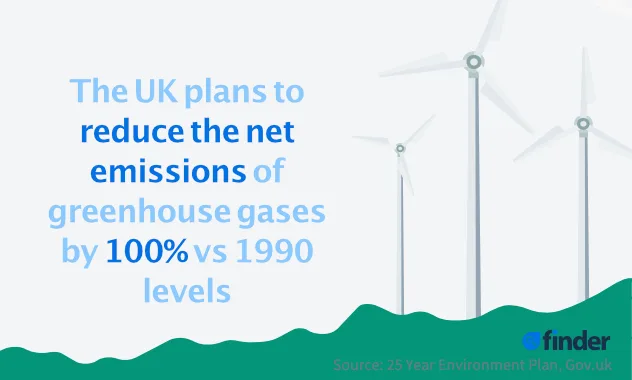- Start investing from $100
- Join 30 million users who trust their investments with eToro
With clean energy moving out of the fringes and into the mainstream, the renewable energy industry is seeing rapid growth. The UK is committing to invest in wind power to reach net zero emissions by 2050 according to an announcement on October 6 2020 from Boris Johnson. The UK government hopes to make the UK the world leader in clean wind energy. We’ve compiled some ways that you can invest in renewable energy including some pros and cons.
How to invest in renewable energy
Aside from rooftop solar panels, there are many other options when it comes to investing in the renewable energy sector. Here are the main ones:
Strategy 1:
Purchase shares in renewable energy companies
Another way to invest in clean energy is through the purchase of individual shares. The nature of these shares is that their prices can be incredibly volatile, especially in newer, niche industries such as renewables.
You could reduce some of this risk by investing in companies that do more than just renewables, such as General Electric (GE), who have large exposure to wind power through their branch GE wind, and Siemens (SI), who have large investments in solar panels and wind turbines.
Stocks in companies focused entirely on renewables have a higher risk, with high potential returns. Various renewable energy companies you might want to consider include European wind turbine manufacturers Vestas Wind Systems, First Solar, Greencoat Renewables, and Gamesa Corporacion Tecnologica.
Pros
- You can tailor your own portfolio.
- A simple and accessible way of investing.
Cons
- Shares can be volatile, especially in niche companies.
- Putting all your eggs in one basket makes the risk of losing your investment higher.
Strategy 2:
Directly invest in renewable energy projects
The most direct way to invest in renewable energy, without installing solar panels on your roof, is to invest directly in renewable energy projects. This method is low-risk, especially in terms of solar PV projects, as once the facility is up and running not much can go wrong.
Community-owned solar farms are increasing in popularity. These projects make it possible for communities to invest in solar together by inviting local people to purchase a share, the funds of which are then used to cover the costs of setting up a solar farm. Once set up, members of the group are able to take advantage of the energy produced and benefit from any profits made.
Pros
- Unlike with rooftop solar, if you move home you retain your share.
- Risk is low
- Community solar projects benefit the local economy, providing jobs through planning, construction, operation and maintenance.
Cons
- Defining factors, such as the weather, can impact a solar farm’s efficiency heavily.
- Solar installations can take useful land out of commission or cause harm to the environment.
Strategy 3:
Purchase renewable energy ETFs
A popular investment strategy is to purchase Exchange Traded Funds (ETFs). While the risk levels are slightly higher, ETFs have higher potential returns. You can check out our ETF guide here.
ETFs give access to a whole load of assets, without having to put all of your money into one or two firms. ETFs work by replicating the performance of major markets or collections of stocks at a lower cost than holding an active fund. If you need to brush up on ETFs, check out our guide.
One of the most well known ETFs in the industry is the iShares Global Clean Energy ETF. While it is still fairly small, the iShares Global Clean Energy ETF offers exposure to 30 of the world’s largest companies involved in clean energy. Another option would be the PowerShares WilderHill Clean Energy Fund (PBW), which tracks the WilderHill Clean Energy index.
Pros
- ETFs provide instant diversification across the renewables industry as a whole.
- Investments come at a low price, with relatively low risk.
- You don’t have to gamble on the success of an individual organisation.
Cons
- The split of assets is out of your control.
- You may be limited to larger companies, reducing your exposure to mid/small cap companies.
Get more detailed information about ethical ETFs (including the best performing ones)
Strategy 4:
Invest in your own renewable energy project
Experienced investors willing to take the risk may consider investing in their own renewable energy projects. This requires large initial investments for equipment and the land space to host your renewable energy farm. You will also need to obtain interconnection authorisation and a power purchase agreement.
Once you have achieved all this, the energy your farm generates can often be sold for a substantial profit. However, return on investment can vary wildly, fluctuating costs of developments and power make these projects high-risk investments.
Pros
- Returns can be substantial.
- You have a great deal of control.
- If you own a commercial building and have the space, a solar farm can reduce energy bills, generate income and improve your organisation’s green credentials.
Cons
- A large initial investment is required, meaning the risk is higher.
- Experience and expertise are necessary.
- A project takes a great deal of dedication, time and effort.
Why should I invest in renewable energy?
- As worldwide energy consumption rises, and resources such as fossil fuels decline, the demand for sustainable, renewable energy sources is growing rapidly.
- The world is becoming more environmentally conscious, renewables can be an ethical investment.
- As the technology behind renewable energy production advances, renewable resources are becoming more efficient, reliable and lower in cost.

Risks to consider
- Renewable energy is still a specialist area, meaning the risks are higher.
- When newer or smaller companies run into trouble their value can plummet dramatically. This makes renewables a volatile investment.
- While many governments are encouraging renewable energy, an unpredictable change in public policy has potential to negatively impact investors.
Bottom line
It’s natural to want your investments to do good, so investing in renewables is an obvious choice. This is a relatively new area, which can increase the risks and means you may not see returns for a little while. You might also want to look into ESG investing, which is investing based on a scoring system that looks at how companies impact the environment, society and governance.
Finder survey: If a pension or other investment performed well but included companies in the following industries or countries, which would cause you to feel guilty?
Response | 55+ | 45-54 | 35-44 | 25-34 | 18-24 |
|---|---|---|---|---|---|
| A Russian company | 48.96% | 42.73% | 39.06% | 37.18% | 20.09% |
| A company still operating in Russia | 42.47% | 36.05% | 33.13% | 32.28% | 18.22% |
| Weapons manufacturing | 31.17% | 39.24% | 34.38% | 34.01% | 20.09% |
| Tobacco | 29.09% | 24.42% | 24.38% | 24.21% | 19.63% |
| I wouldn't feel guilty | 28.05% | 18.9% | 22.5% | 17% | 16.36% |
| Cannabis | 25.84% | 19.77% | 15.63% | 21.33% | 19.63% |
| Oil | 9.09% | 12.21% | 12.5% | 14.7% | 20.09% |
| Meat farming | 8.83% | 15.7% | 14.06% | 21.61% | 14.49% |
| None of the above | 8.31% | 11.92% | 10.31% | 9.8% | 8.88% |
| Banks | 4.29% | 6.1% | 11.56% | 8.65% | 12.15% |
| Vaccine production | 4.16% | 7.27% | 6.56% | 10.66% | 11.21% |
Frequently asked questions
More guides on Finder
-
Best hydrogen stocks (2025)
Learn how to invest in hydrogen fuel cell and infrastructure stocks in just a few steps.
-
Buy Saudi Aramco shares
Saudi Aramco is an oil company in Saudi Arabia. Find out if you can buy shares in Saudi Aramco and alternative ways to invest.
-
How to buy Petro Matad shares
Thinking about buying shares in Petro Matad? We explain how to do it and compare a range of providers who will give you access to global markets.
-
How to buy BP shares
Monitor BP share price performance and compare brokers who offer access to BP shares. We’ll also run through a checklist for anyone looking to invest and buy BP stock.
-
How to buy Shell shares
Thinking about buying shares in Royal Dutch Shell? We explain how to invest in Shell and some top UK investing platforms that will give you access to global markets.
-
How to buy ContourGlobal shares
Ever wondered how to buy shares in ContourGlobal? We explain how and compare a range of providers that can give you access to many brands, including ContourGlobal.
-
How to buy SSE shares
We walk you through how to buy shares in SSE, covering all of the costs and fees you could come up against. We also have a checklist for anyone looking to invest in a company.
-
How to invest in gas
Learn how to invest in natural gas, and about gas’s historical performance as an investment. Find out all the need-to-knows with our extensive guide.
-
How to buy Gazprom shares
Compare brokers to decide where’s best to invest in Gazprom and read our useful checklist on what to look out for in a companies characteristics.

